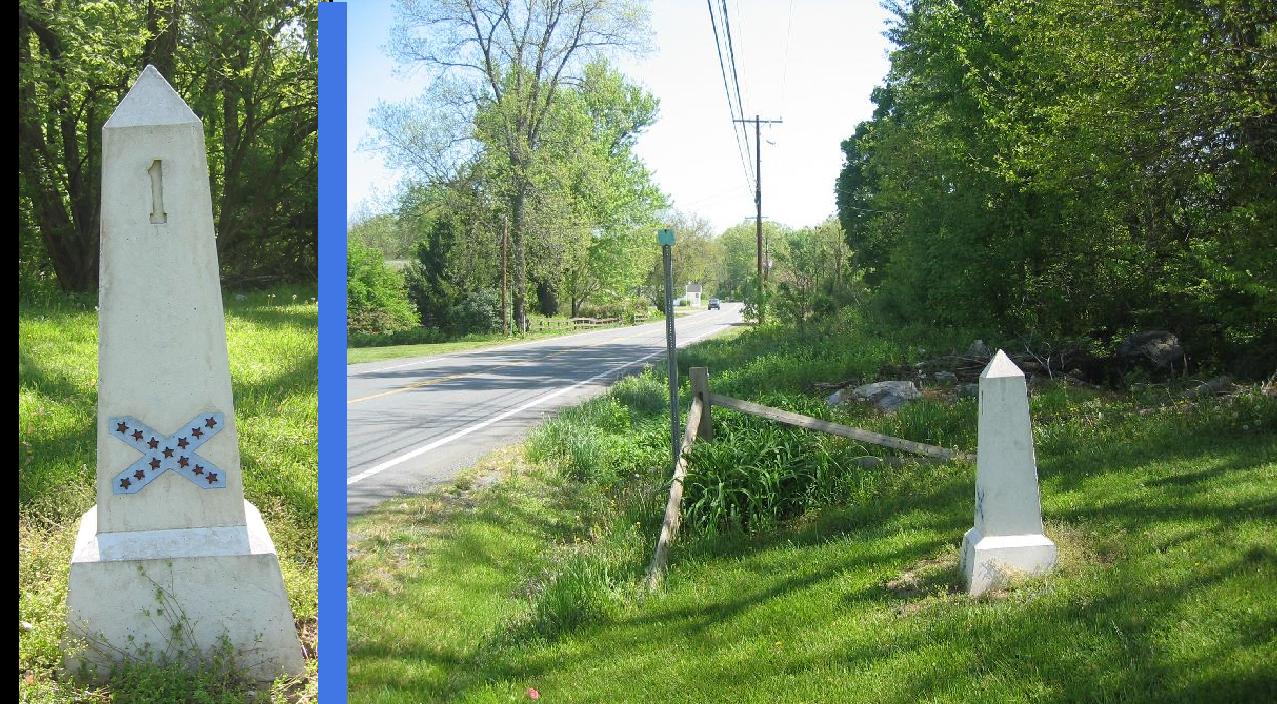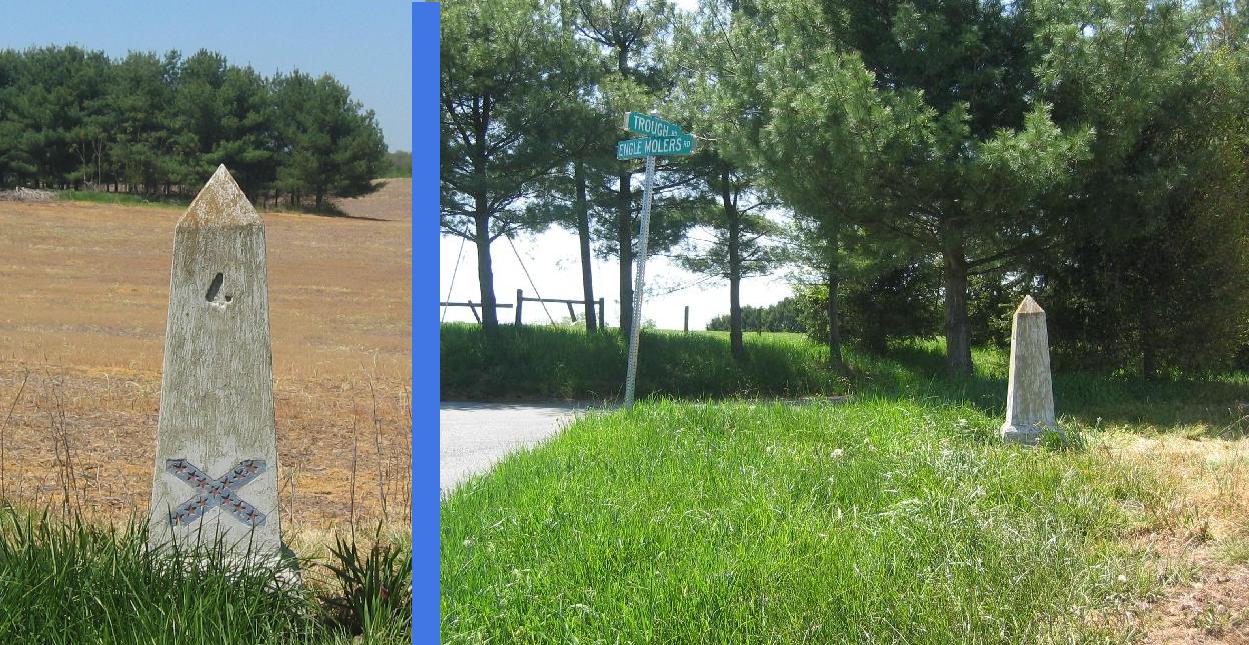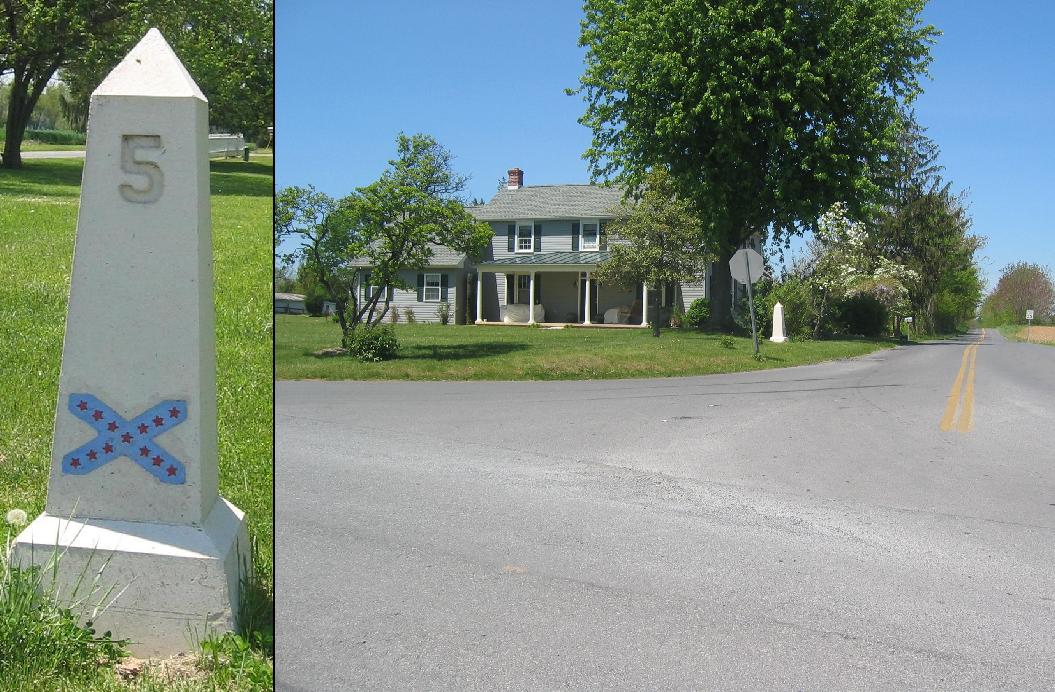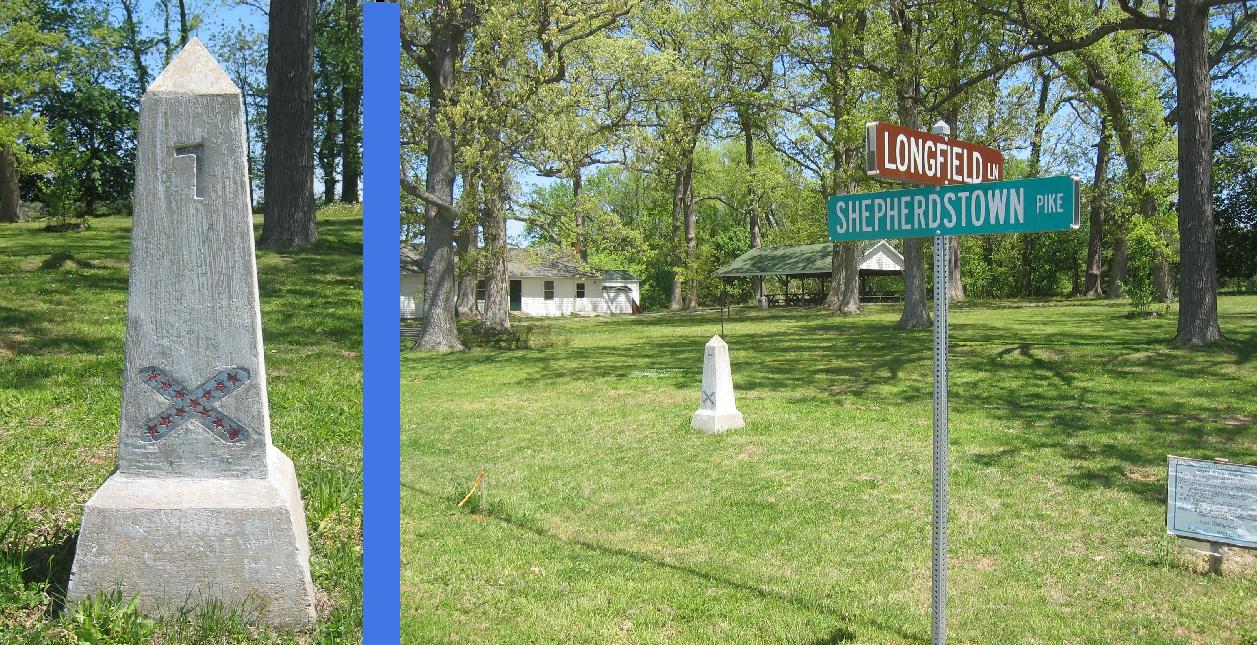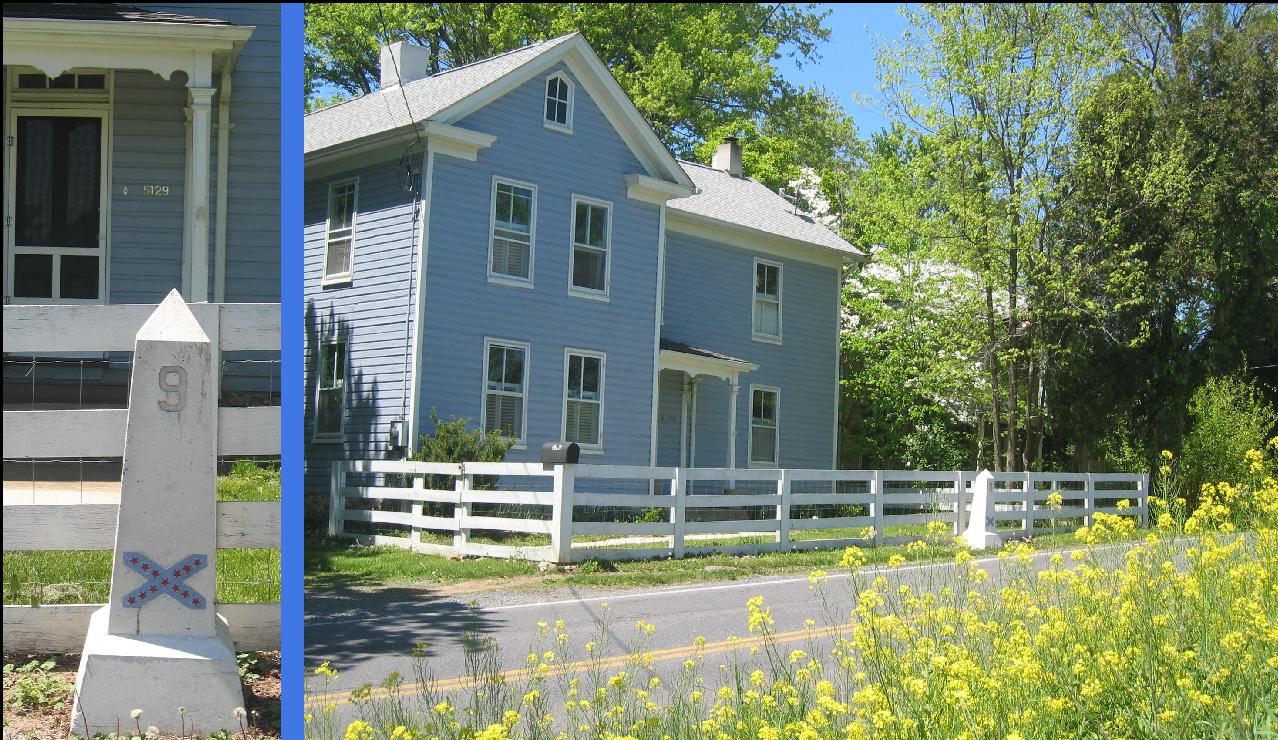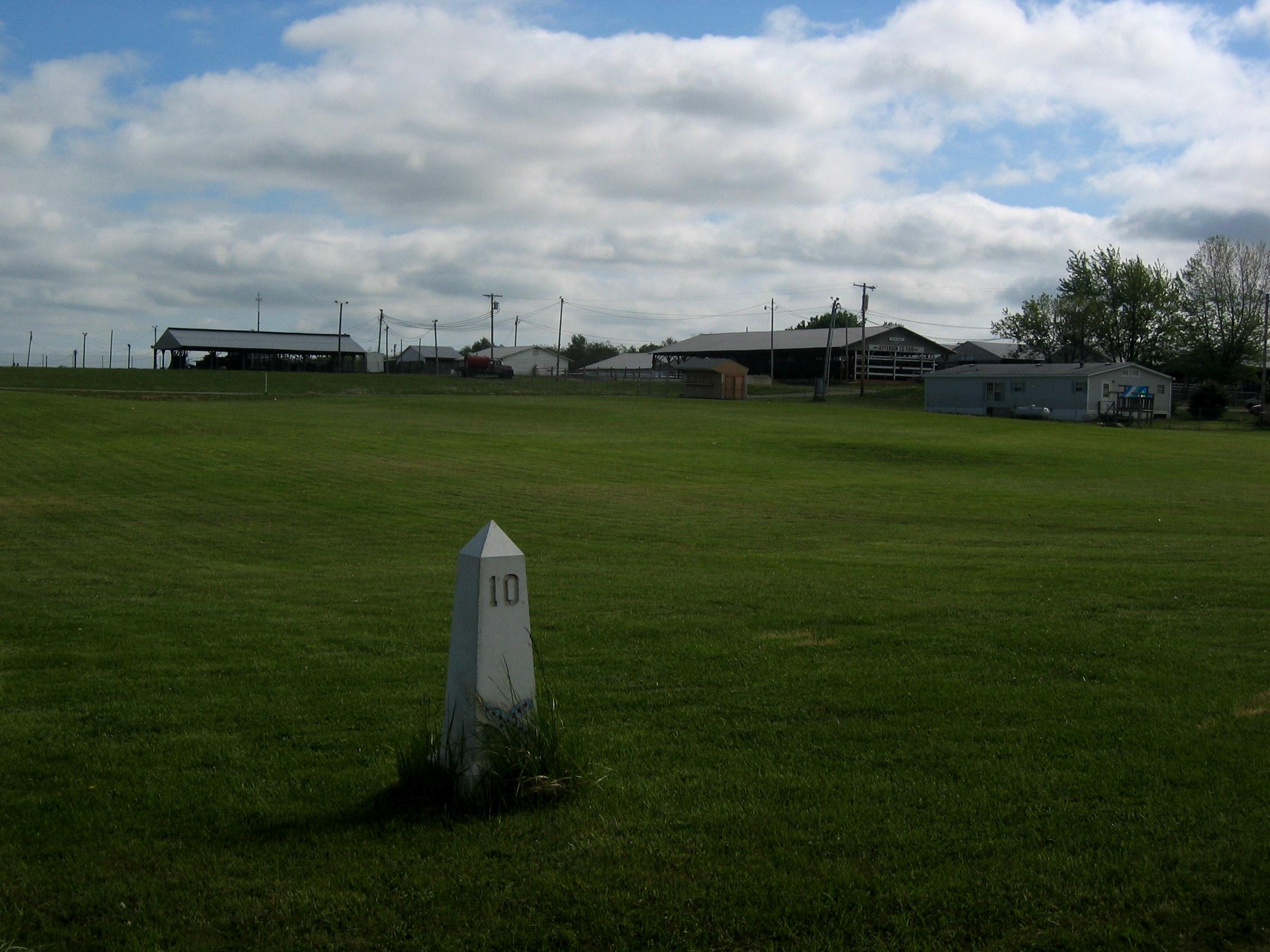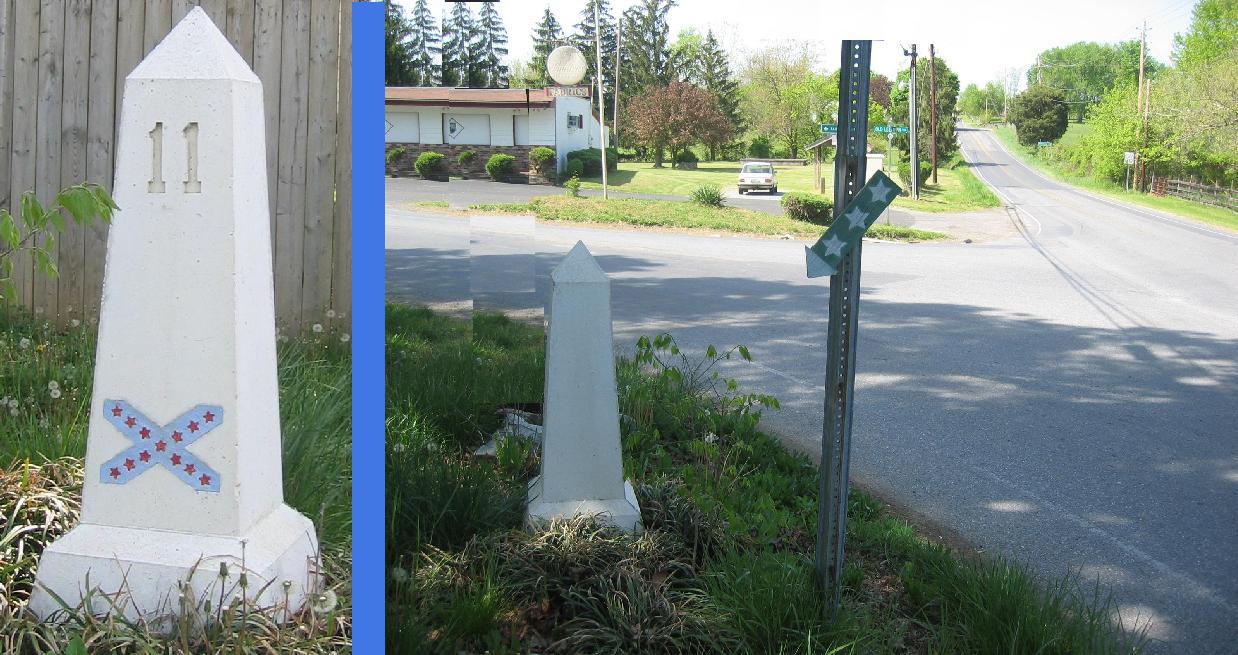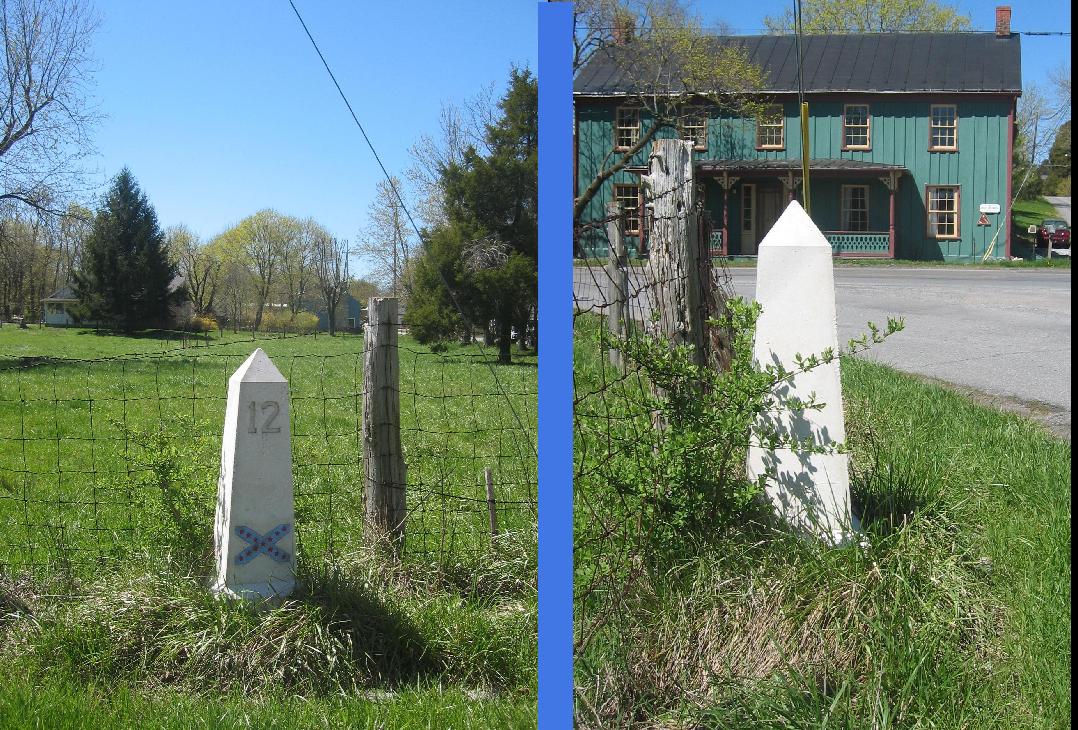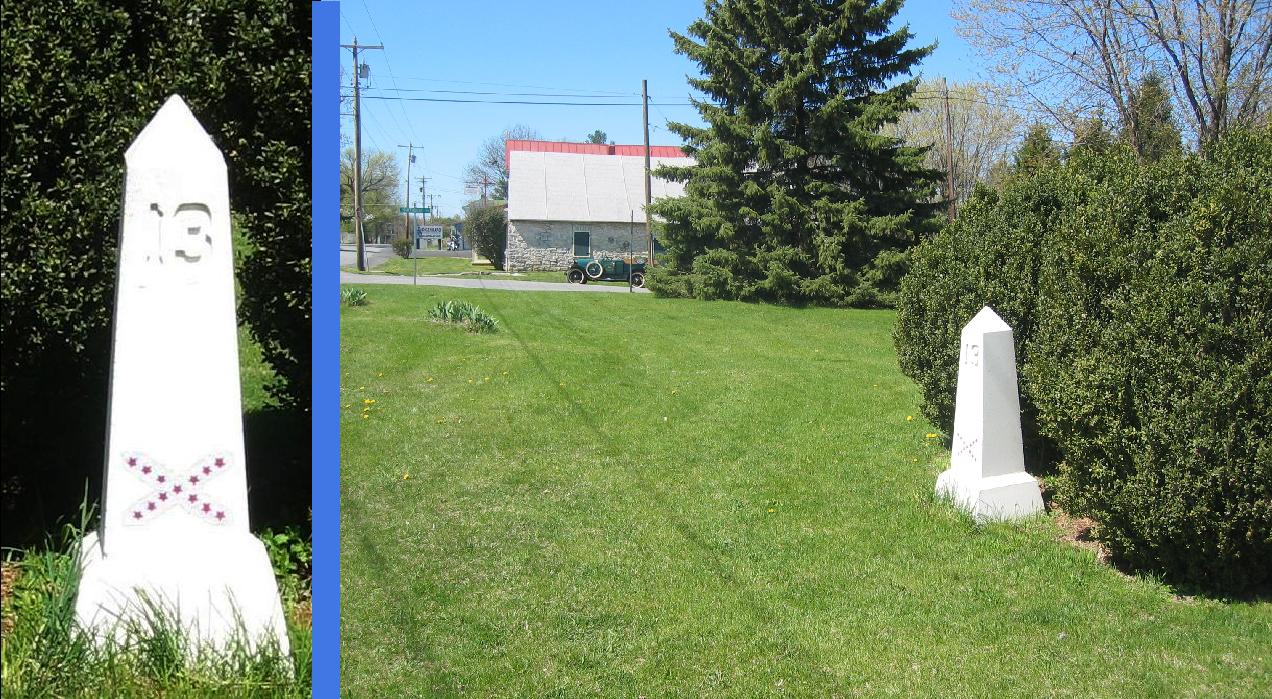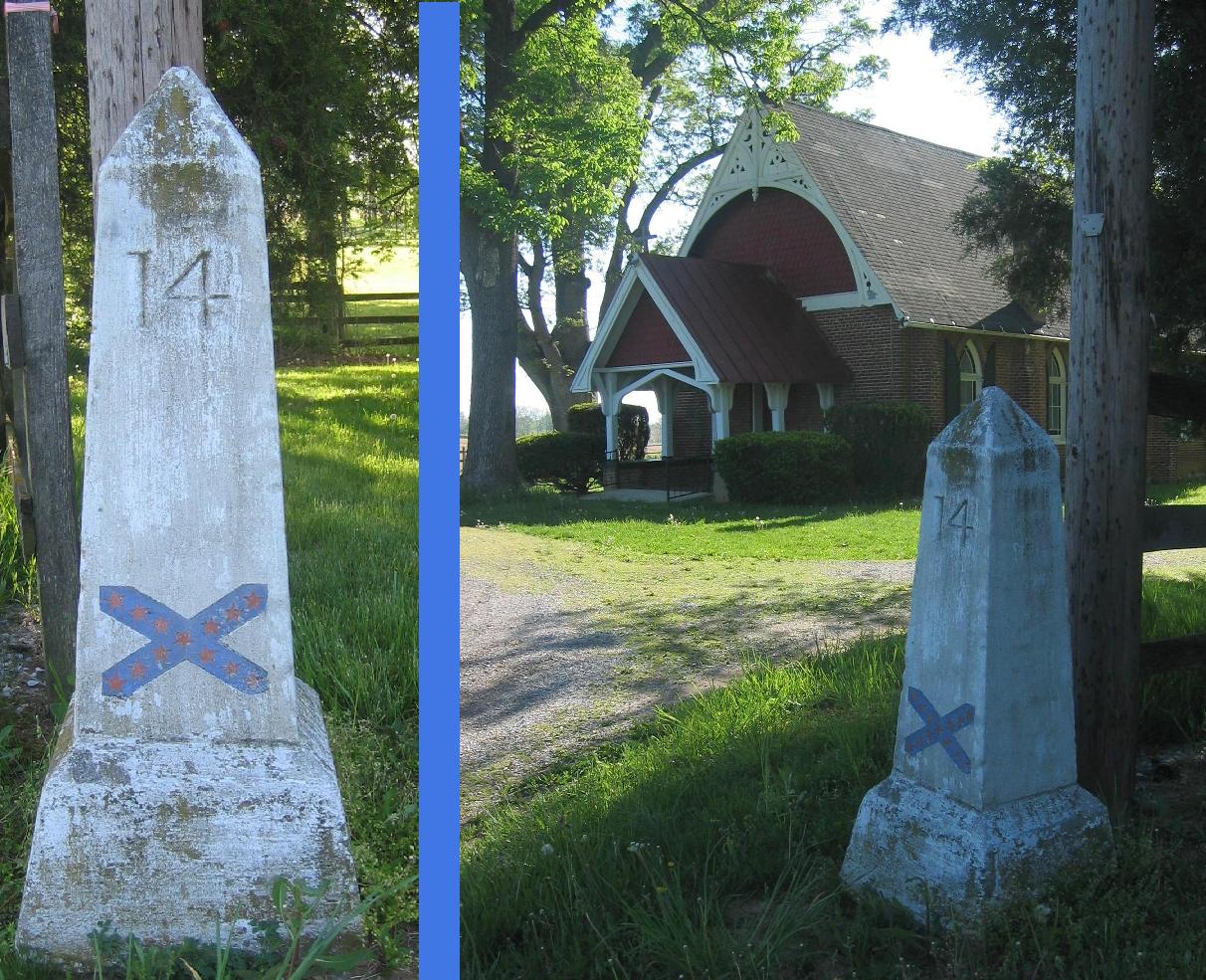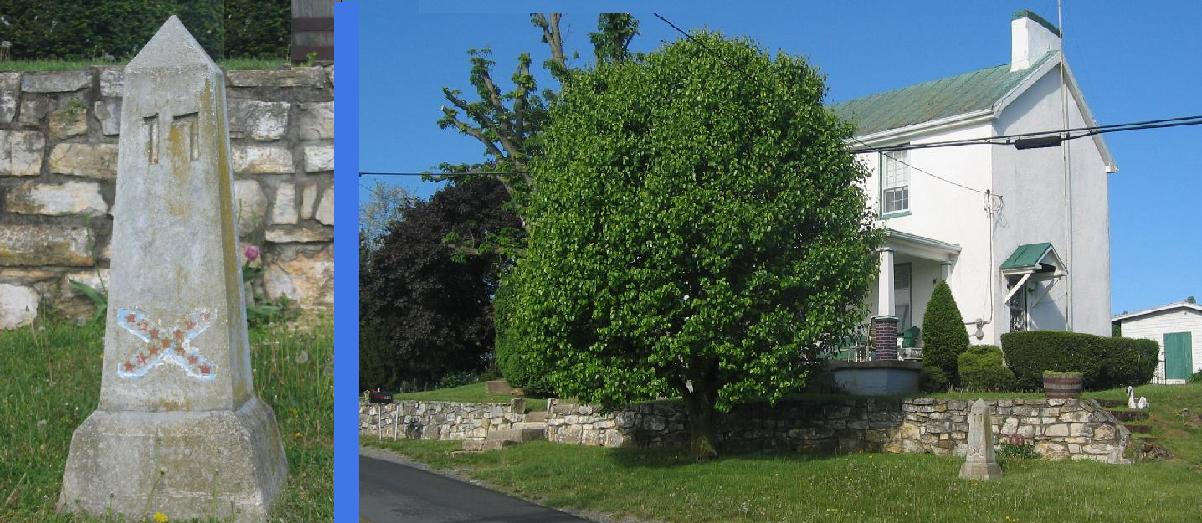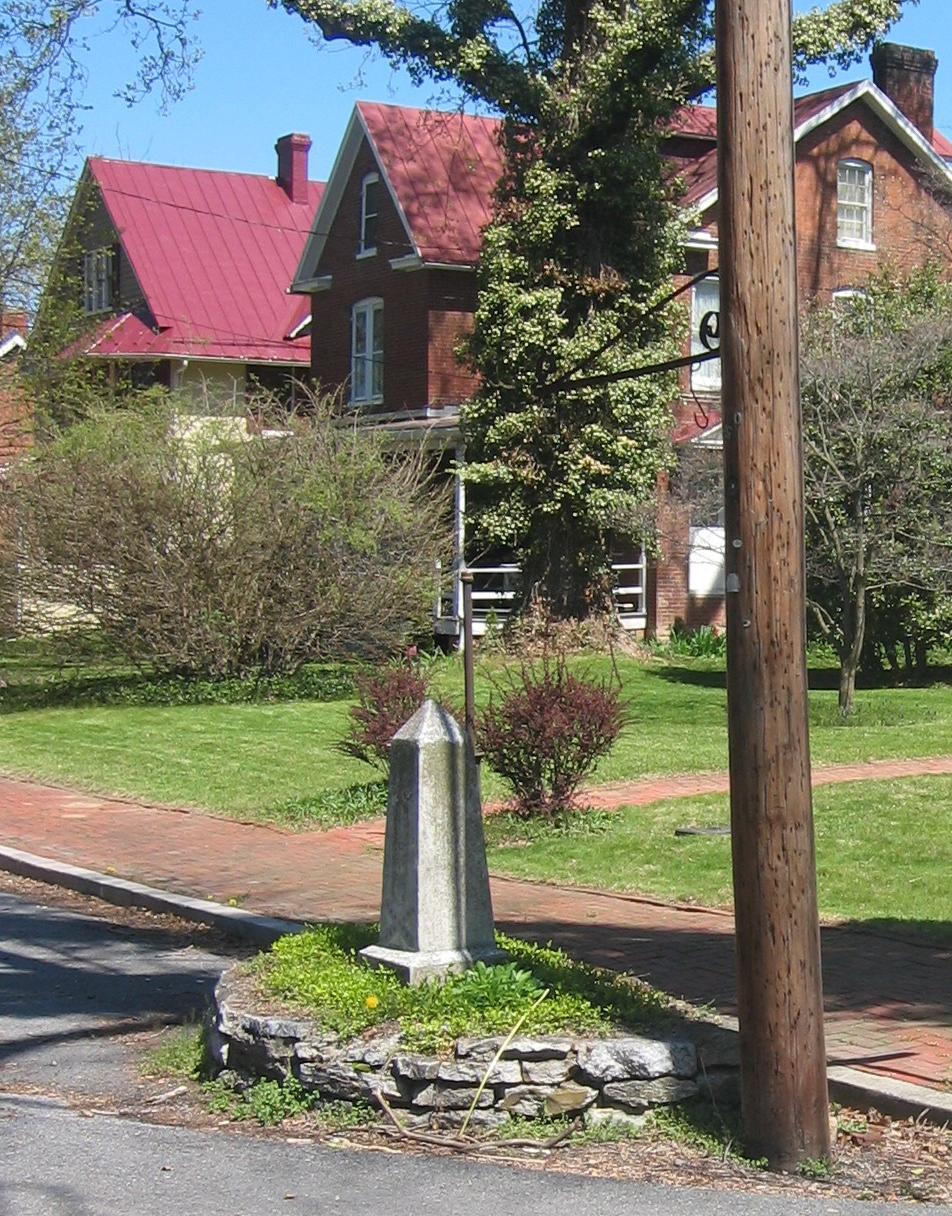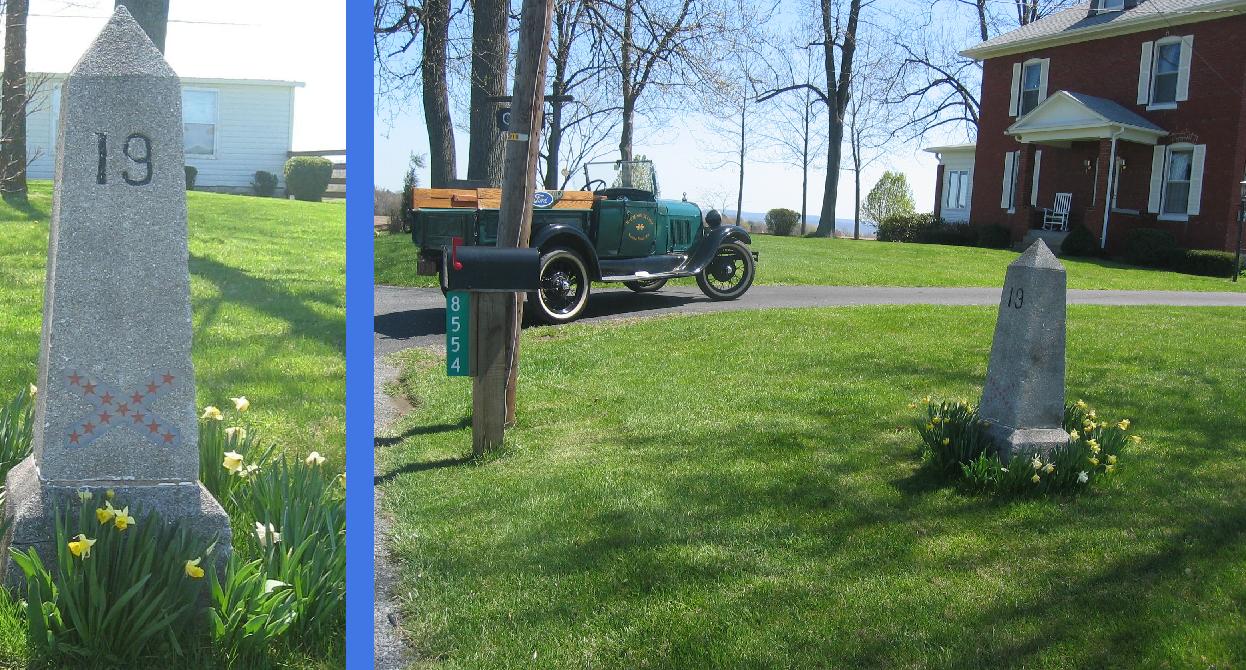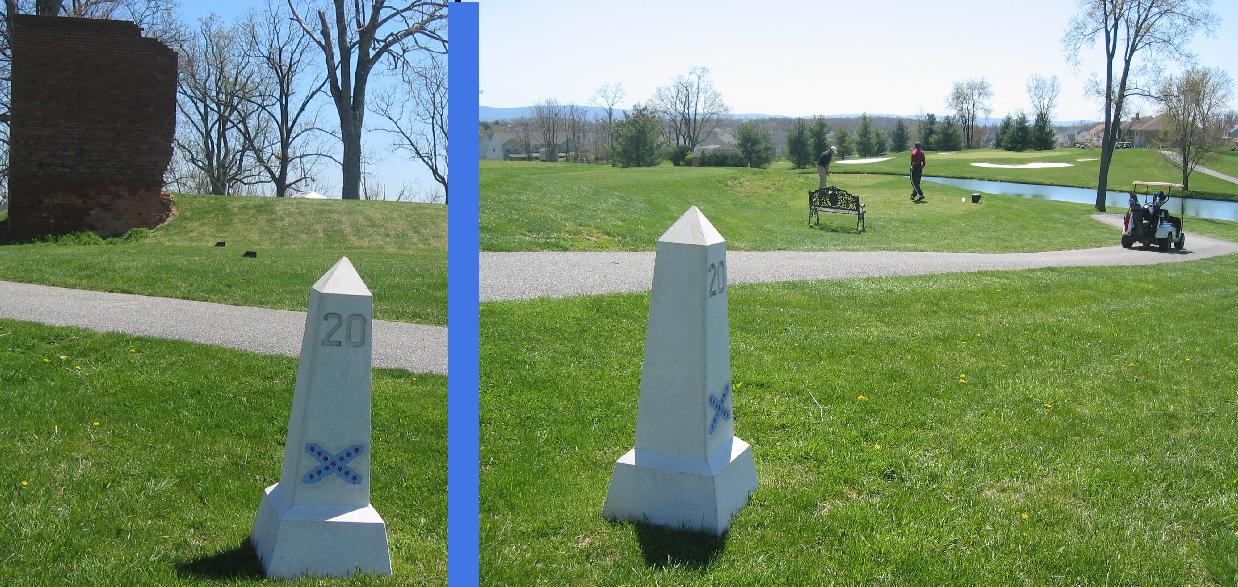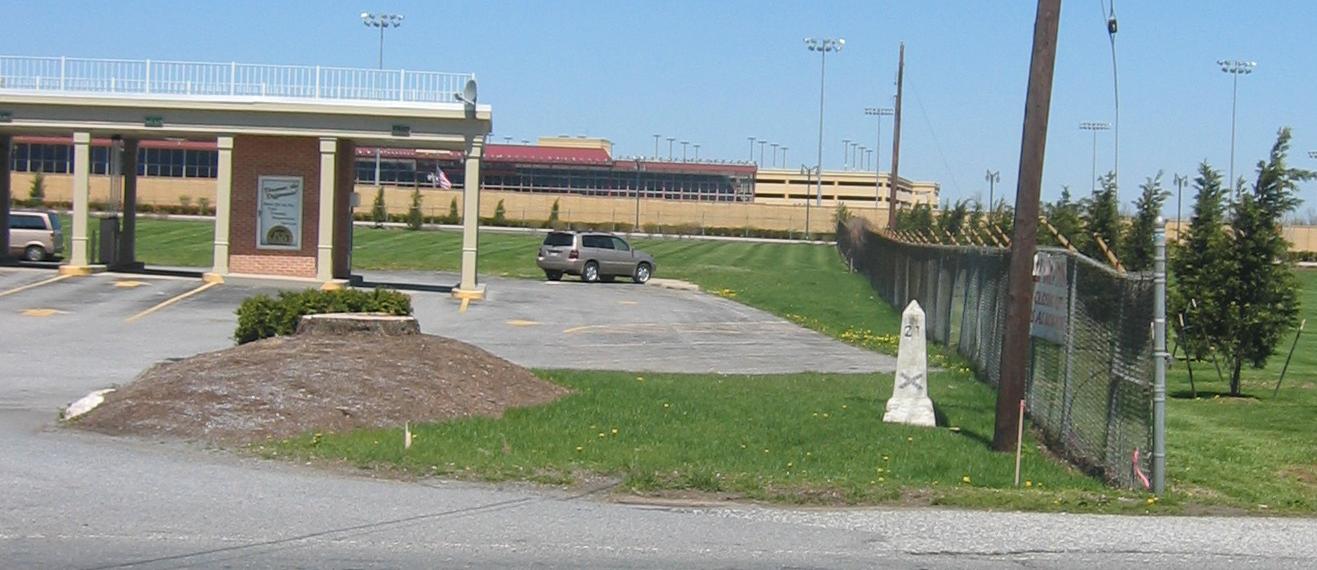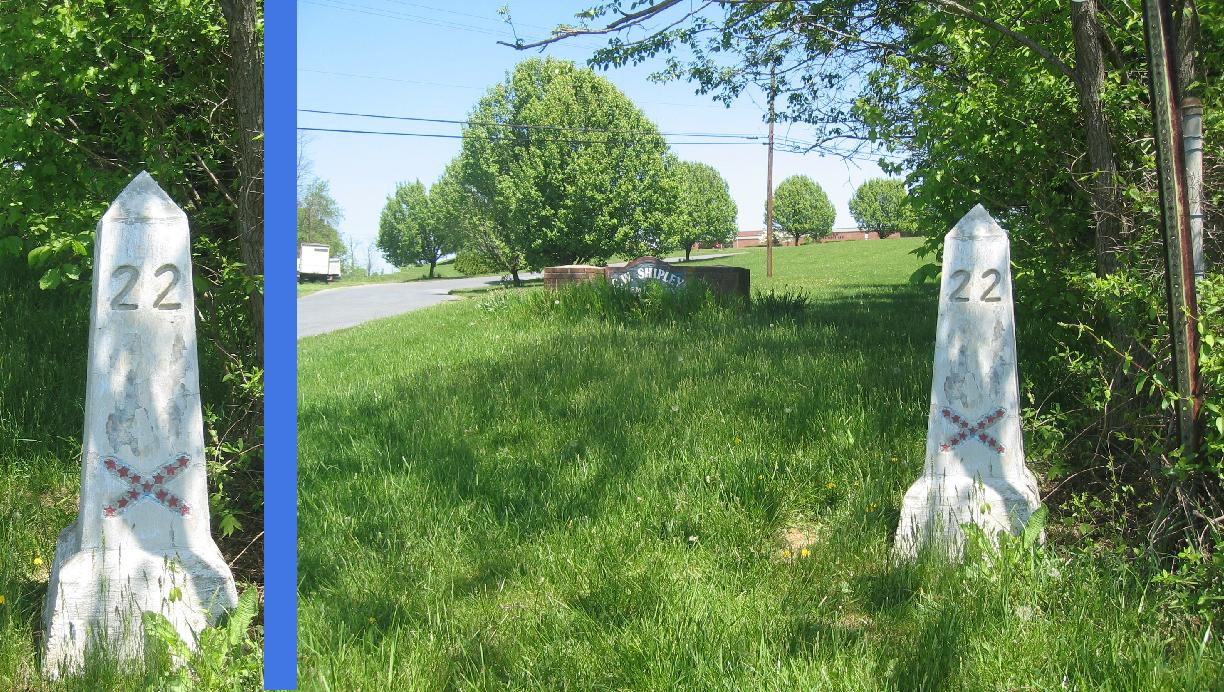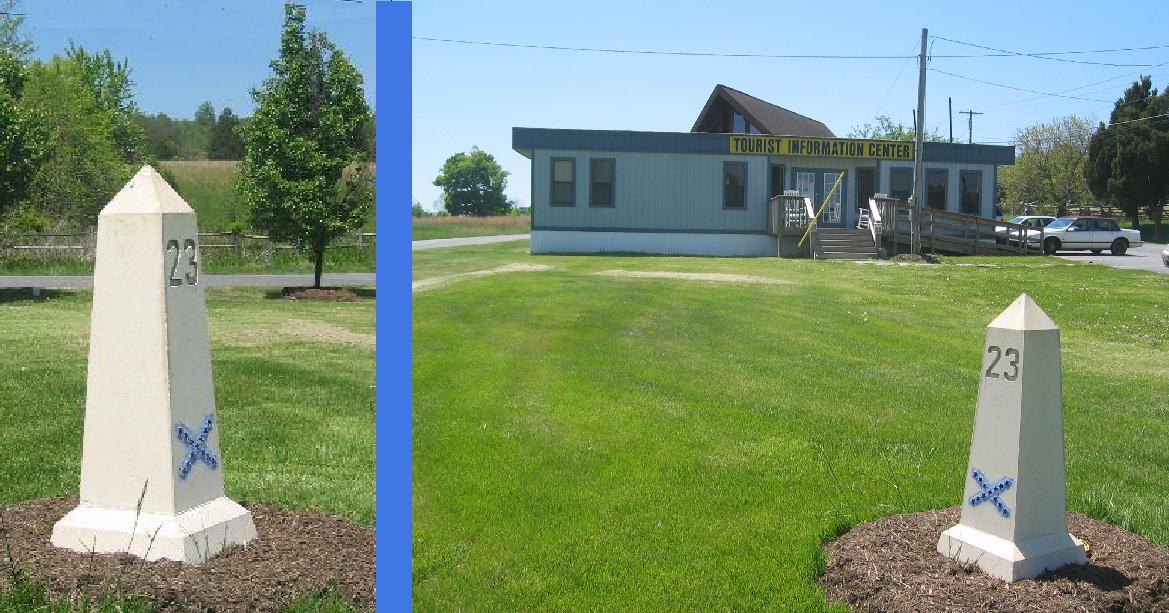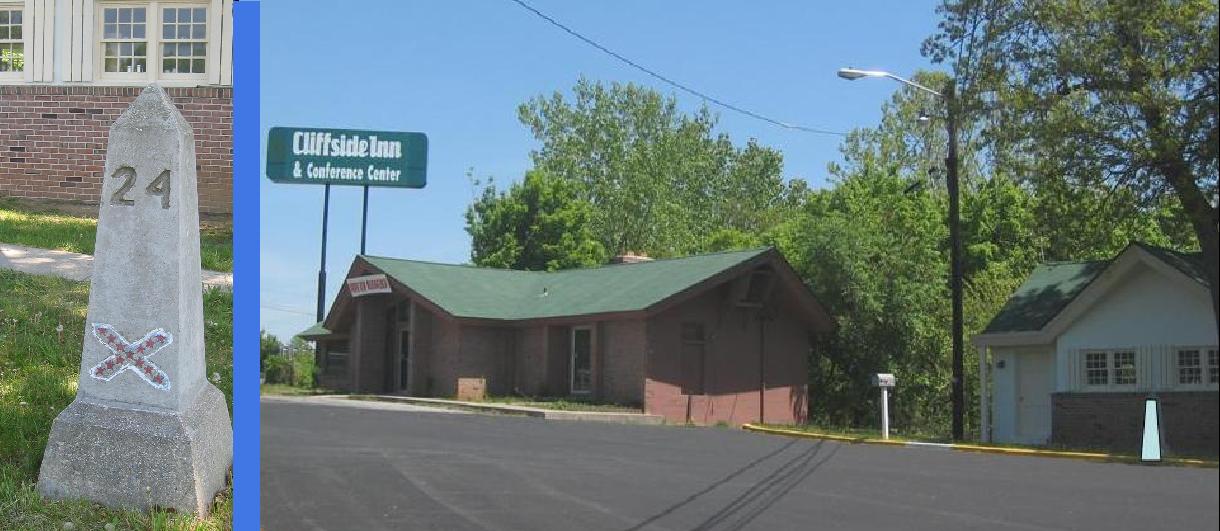Military Operations: 1861-1865
Explore the military operations of the Civil War in Jefferson county via our digital map and summaries below.
Civil War Markers
In 1910 the Jefferson County Camp, United Confederate Veterans made plans to commemorate the 50th anniversary of the War Between the States. Ably led by Col. R. Preston Chew, the Camp set about to permanently mark locations throughout Jefferson County where skirmishes or battles took place during the Civil War. Funds were raised by the Camp to place 25 concrete obelisks. Each site would serve as a reminder to posterity of the sacrifices made by the men who fought there.
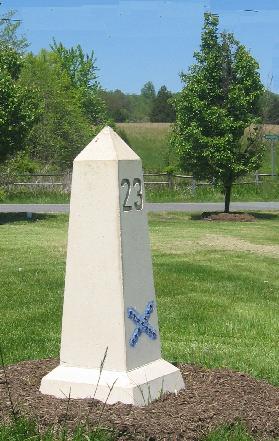
In 1911 it was decided to publish a pamphlet to accompany the concrete obelisks. The pamphlet would provide a brief description of the action that took place at each site. Again Col. Chew provided the leadership that resulted in the publication of Military Operations in Jefferson County Virginia (Now West Virginia) 1861-1865. By reading accounts written by men who had first-hand knowledge of The War Between the States, it is possible to have a clearer understanding of their experience. What follows is a summary of the accounts written about each site. Direct quotes from the text are in italics. Where possible full names of men mentioned in the account are given. The spelling of local sites is as it appears in the pamphlet.
The pamphlet included a map that showed the locations of each of the concrete obelisks, numbered 1 through 25. This map has been used as the basis for the map shown on this web site. As of spring 2007, all markers had been found. Their locations as of May 2007 are described and identified by latitude and longitude and with photographs depicting their settings. However, it must be kept in mind that for a number of reasons the markers themselves may not be located at the site of the event they commemorate. Many have been moved from their original locations, such as Marker #16, which was moved away from the Shenandoah River, apparently to ensure it was not swept away in a flood. In some cases, the initial location itself was not intended to mark the actual spot of the event. Where possible, we have identified such situations below. However, individuals aware of the reasons for such discrepancies or of other situations affecting the accuracy of our descriptions are encouraged to contact us so that we might make the information public.
The booklet was published in 1911, and reprinted in 1960, 1994, 1996, 1999, and in 2004 by the Henry Kyd Douglas Camp, No. 199, Sons of Confederate Veterans. The 2004 edition is available for purchase at selected locations in Jefferson County, West Virginia.
The Jefferson County Historic Landmarks Commission is grateful to the Henry Kyd Douglas Camp, No. 199 of the Sons of Confederate Veterans for permission to post this information
Marker Locations and Events Commemorated
“Kearneysville, Uvilla, Crossing of Uvilla and Charles Town Roads”
October 16-17, 1862. Account of action between Confederate forces led by Gen. Winder (including Fitzhugh Lee’s and Hampton’s Brigades of Cavalry) and Union forces under the command Gen. Humphrey. Confederate forces succeeded in driving Humphrey’s men across the Potomac River and back into Maryland. “If the position were carried his retreat was endangered.”
MARKER NUMBER TWO:
“Butler’s Woods, Moler’s Cross Roads, and Uvilla”
July 16, 1863. Action between Union cavalry and two brigades of Confederate cavalry led by Gen. Fitzhugh Lee and Gen. John R. Chambliss, Jr. Following the Battle of Gettysburg, the Confederate army retreated back to Virginia. The Confederate Cavalry was picketed from the Shenandoah to the Potomac River to warn of a Union advance. Union forces crossed the Potomac at Shepherdstown and ran into the Confederate pickets north of Kearneysville. The Confederates succeeded in pushing Union troops to Butler’s Woods and eventually back across the Potomac. “Colonel (James H.) Drake, of the First Virginia Cavalry, was mortally wounded, and died that night at Mr. Marshall’s. About 40 feet from Marker No. 2, measuring west, is the place where he was shot. He was an able officer.”
MARKER NUMBER THREE:
“Shepherdstown Through Four Years of War”
This marker chronicles the events that occurred in and around the Shepherdstown area during the Civil War.
Following the Battle of Sharpsburg (September 17, 1862), Shepherdstown became a field hospital for a portion of the 21,000 casualties of the battle. Virtually every building in the town became an oasis for the wounded and dying. The town was overwhelmed by the necessity to house, feed, and provide medical care
For most of the War Shepherdstown found itself in a tug of war between Union and Confederate troops. Law enforcement was hit and miss resulting in a number of atrocities committed on the civilian population by undisciplined soldiers.
Shepherdstown sent two companies of men into Confederate service – Company “B” [Hamtramck Guards], 2nd Virginia Infantry Regiment, “Stonewall Brigade,” and Company “F” [Shepherdstown Troop], 1st Virginia Cavalry. “The country was without law for the four years, and robbery was frequent by men claiming to be sent by the Federal government, which, in some instances, was true. There was no recourse.”
MARKER NUMBER FOUR:
“Slaughter at the Cement Mill on the Potomac”
This is an account of the Battle of Shepherdstown. Following the Battle of Sharpsburg on September 17, 1862, General Lee began moving his army southward back to Virginia on the night of September 18th. The army crossed the Potomac River at Pack Horse Ford without incident. General Lee left a rear guard in place along the cliffs overlooking the river to protect the army as it continued its withdrawal. An advance of the Union army on September 19th and 20th threatened the Confederates, so Confederate General A. P Hill with his division was dispatched to stop the Union pursuit. Hill’s Division successfully repulsed the Union advance literally pushing the Union troops back across the Potomac River. One Union regiment, the 118th Pennsylvania Volunteers known as “The Corn Exchange Regiment,” suffered high numbers of casualties crossing the Potomac with 737 officers and men and re-crossing with 468. The Confederate loss was 34 killed and 231 wounded. “Soldiers of the Light Division, you have done well. I am well pleased with you. You have fought in every battle from Mechanicsville to Shepherdstown, and no man can say the Light Division was ever broken.”
MARKER NUMBER FIVE:
“Butler’s Woods, Moler’s Cross Roads, and Uvilla”
July 16, 1863. Company “D,” 12th Virginia Cavalry, moved northeast to Moler’s Cross Roads. When Maj. John L. Knott relieved Capt. Kearney, he sent the prisoners “back to safety.” Company “D” ran in to Union reinforcements moving from Harpers Ferry to assist Union troops which had crossed the Potomac at Shepherdstown and engaged Confederate cavalry led by Gen. Fitzhugh Lee and Gen. John R. Chambliss, Jr. The work of Company “D” succeeded in delaying Union reinforcements so that they were unable to come to the aid of their compatriots near Shepherdstown. “This timely check of this brigade fro three hours undoubtedly saved the day on the pike at Butler’s woods.”
MARKER NUMBER SIX:
“Kearneysville, Uvilla, Crossing of Uvilla and Charles Town Roads”
October 18, 1862. “The losses on both sides were considerable. No estimate of the losses could be found. Our badly wounded (see Markers One & Eight) were taken to the Uvilla churches and neighboring farm houses, and cared for. Many wounded had been left at these churches after the Battle of Sharpsburg, and those unable to get away were paroled by the Federals.”
MARKER NUMBER SEVEN:
“Butler’s Woods, Moler’s Cross Roads, and Uvilla”
July 16, 1863. Company “D,” 12th Virginia Cavalry, led by Capt. Henry Walper Kearney, picketed both directions of the Halltown Pike (SR 230) and captured 33 prisoners and seized the headquarters wagon of the 2nd Brigade, 2nd U. S. Cavalry Division. “This was continued until thirty three prisoners, their horses and equipments, and the General’s head-quarters wagon with his extra clothing, camp fixtures, and bedding, and two fine horses and harness, and servant were captured.”
MARKER NUMBER EIGHT:
“Kearneysville, Uvilla, Crossing of Uvilla and Charles Town Roads”
October 17, 1862. Action between Company “D,” 12th Virginia Cavalry and Union soldiers that were a part of Gen. Humphrey’s force. Company “D” was on picket duty near Duffields when it engaged the advance of Gen. Humphrey’s troops. Company “D” succeeded in pushing the Union troops back to Lucas’ Woods near the location of Marker Number Eight. “They easily made their way through the enemy’s lines and joined the Regiment.”
MARKER NUMBER NINE:
“Capture By Mosby – Sharp Encounter at Melvin’s Hill”
Because of the B & O Railroad, the Duffields area was picketed by either the Confederate or Union cavalry for the entire War. This marker summarizes the frequent skirmishes between these mounted troops. On one occasion in July 1863, three Confederate cavalry were surprised by Federal scouts. The skirmish resulted in one of the three Confederates being captured and the Federals suffering one killed and one wounded. “One favorite crossing was about one and one-half miles east of Duffields. Kephart and Melvin’s woods was on either side of the railroad, on elevated ground, and the guard could be flanked unobserved.”
MARKER NUMBER TEN:
“Engagement On and Near the Leetown Road”
On August 21st, 1864, Confederate Gen. Jubal Early had his troops deployed west of Charlestown. The extreme left of the line stretched to the Leetown Pike and was commanded by Col. Harry Gilmore. Gilmore’s men repulsed an attack led by the 12th Pennsylvania Cavalry commanded by Lt. Col. William Bell. During this cavalry assault, several Union troopers were killed or wounded including their leader who received a mortal wound. The Union cavalry regrouped and charged again against a strong Confederate position. 5o Union troopers cut their way through the Confederate line and were captured. Pennsylvania Governor Curtin’s son, who was Lt. Col. Bell’s adjutant and mounted on his wounded leader’s horse, was captured. Col. Gilmore presented the horse to Confederate Gen. Lindsay Lomax. This assault ended the fight and the Union troops withdrew to the vicinity of Harpers Ferry. “When the word to fire was given, a good many saddles were emptied. Among those who were shot was Colonel Bell, who fell mortally wounded.”
MARKER NUMBER ELEVEN:
“Fighting At Wageley’s Shop and In Woods Near Leetown”
On August 25, 1864, Gen. Jubal Early moved a part of his army in the direction of Shepherdstown. His army contacted a force of Union cavalry near Wagely’s Shop that was quickly disposed of. Moving along the road to Leetown Early encountered two divisions of Union cavalry. Early pushed the Union cavalry back to Kearneysville were they took up a strong defensive position. The Union troopers were finally dislodged and pushed back to the vicinity of Shepherdstown where a part of the force crossed the Potomac at Pack Horse Ford while the remaining troops withdrew to Harpers Ferry. “In one of the charges made by Gordon and his men that General was wounded in the face by a sabre slash.”
MARKER NUMBER TWELVE:
“Successful Exploits of Confederate Forces About Smithfield”
A chronicle of events that occurred in the Smithfield area (now called Middleway) during 1862, and 1863. In August 1862, Jefferson County residents Lt. George Baylor and Lt. Milton Rouss of Company “B,” 12th Virginia Cavalry, led 30 troopers to attack the Winchester & Potomac Railroad between Summit Point and Cameron’s Depot. The raid was successful resulting in the capture of eight Union soldiers, $4,000 in cash, and food stores. After sending the prisoners south, Rouss and Baylor proceeded to Smithfield where they took 17 Union prisoners and “other trappings.” The express car was opened, where they found baskets of champagne and boxes of fruit. It is needless to say, as the men were thirsty and hungry, they proceeded to partake of these good things.”
In February 1863 Rouss and Baylor returned to Summit Point where they learned that a scouting party of 21 Union troopers were on the road to Smithfield. Proceeding to Smithfield the Confederates ran into the rear of the Union scouting party killing four Union troopers, wounding seven, and capturing seven men and their horses without suffering a Confederate loss. After leaving Smithfield, the Union cavalry pursued the Confederates capturing Lt. George Baylor.
MARKER NUMBER THIRTEEN:
“An account by Col. Harry Gilmor of His Fight with Somers Near Summit Point”
In the fall of 1863 Confederate Col. Harry Gilmor left his camp at Mt. Jackson headed to Hagerstown to capture Union horses and mules. They were able to slip through Union pickets around Charlestown, but they discovered the Potomac was too high to cross, so they turned around.
However, the skirmish occurred at White House Farm, 3735 Summit Point Road (39 15.071N; Latitude 77 56.759W). It is not known whether the original marker was placed at White House Farm and subsequently moved or whether it was originally placed in the village. Regardless, during recent efforts to replace the old original markers with new one-piece models, the original #13 marker was installed at the site of the skirmish while the newer one resides in the village.
After dismounting Gilmor was talking to the ladies of White House Farm when the 2nd Potomac Home Brigade Maryland Infantry commanded by Capt. George Denton Summers attacked his troop. After a sharp engagement, the Confederates were able to form up and push the Union cavalry through Summit Point. During the attack, Col. Gilmor shot and killed Capt. Summers. 18 Union cavalrymen were taken prisoner. “Captain Somers was highly esteemed by his commanding officers, as shown by a long article, highly complimentary to him, that appeared a few days after. The same paper also alleged that I had murdered him! Indeed! Then not a few were murdered on both sides.”
MARKER NUMBER FOURTEEN:
“Repulse of Federals by Imboden at Rippon – The Retreat”
On October 18, 1863 Confederate Gen. John Imboden attacked Charlestown in an attempt to dislodge the Union troops garrisoned there. The assault was successful and Imboden captured several hundred Union soldiers. Moving south along the Berryville Turnpike, Imboden was attacked by a union force that had advanced from Harpers Ferry. Imboden formed a line of defense just north of Rippon and succeeded in holding off the Union attack. “There were a number of killed and wounded on each side in this action.”
MARKER NUMBER FIFTEEN:
“Slaughter and Capture of Blazer’s Men at Myerstown”
In the fall of 1864, the Union army had assembled a group designated the “Independent Scouts” whose sole purpose was to eliminate the threat of Col. John S. Mosby’s 43rd Virginia Cavalry Battalion. Mosby’s Rangers, as the battalion had become known, spent their time disrupting the B & O Railroad and capturing Union soldiers, horses, and supplies.
Capt. Richard Blazer led a company of scouts to the vicinity of Kabletown. Confederate Lt. Aldolphus (Dolly) Richards led a band of 100 Mosby’s Rangers to track Blazer down. On November 17th, Richards found Blazer camped near Kabletown. The fight that ensued resulted in the decimation of Blazer’s troops. “General Stevenson dispatched on November 19, ‘two of Captain Blazer’s men came in this morning – Privates Harris and Johnson. They report that Mosby attacked Blazer near Kabletown yesterday about 11 o’clock. They say the entire command, with the exception of themselves, was either captured or killed.”
MARKER NUMBER SIXTEEN:
“Engagement at Myers Ford, Sunday Sept. 5, 1864 – Blazer’s and Mosby’s Men”
On Sunday, September 5, 1864, Col. John S. Mosby left Loudoun County with two companies headed to Jefferson County. They crossed the Shenandoah River at Myers Ford. Mosby and six rangers proceeded to Charlestown leaving the rest of the men in camp near the ford.
At the same time Capt. Richard Blazer left Charlestown with company of “Independent Scouts” to find Mosby. Blazer crossed the Shenandoah and headed to Hillsboro only to discover that Mosby had left there and had headed to Jefferson County.
Blazer followed the route that Mosby had taken and surprised Mosby’s men camped at Myer’s Ford. During the fight 13 Confederates were killed, six wounded, and five were captured. Blazer lost one killed, three wounded, and three were captured. “The men in camp being totally unprepared for an attack, scattered when the attack was made in all directions, the most of them having no time to saddle and mount their horses.”
MARKER NUMBER SEVENTEEN:
“General Bradley T. Johnson Repulses The Enemy Near Kabletown”
“In the latter part of August, 1864, General Bradley T. Johnson, with his brigade of cavalry and a force of infantry, moved to Kabletown and encountered a large force of infantry of the enemy. An engagement followed, in which, after a good deal of severe fighting, a charge was made by Johnson, and the enemy, were driven down the Shenandoah River. The result of this engagement was considerable killed and wounded.”
MARKER NUMBER EIGHTEEN:
“Charles Town The Scene of Many Engagements”
Marker Eighteen chronicles the War years in Charles Town.
Late in the evening of May 15th, 1863 Capt. R. Preston Chew of Jefferson County led a squad of 45 men into Charles Town. Approaching from the east, they left their horses near the home of Andrew Hunter. Walking down Liberty Street, the turned south on George Street towards the courthouse. Union soldiers were quartered in the courthouse and the Carter House. The Union sentinel fired on the Confederates and a hot exchange ensued. Chew’s forces overpowered the Union soldiers and captured 60 men and 75 horses. “This capture was made without a single man being killed or wounded on either side.”
On October 18th, 1863, Gen. John Imboden marched to Charles Town to capture the 9th Maryland Infantry, commanded by Col. Benjamin L Simpson, garrisoned in and around the courthouse. Imboden’s line stretched from Potato Hill on the west of town to Tates’ woods on the east. Imboden’s artillery barrage succeeded in dislodging the Union troops. Fleeing Union soldiers were taken prisoner as they ran from the courthouse toward Harpers Ferry. Unfortunately, Imboden’s artillery destroyed the courthouse.
On November 19th, 1864, Capt. George Baylor with 30 men of Company “B,” 12th Virginia Cavalry entered the camp of the 12th Pennsylvania Cavalry bivouacked at Charles Town. When the Union troopers awakened a sharp fight occurred. Several Union cavalrymen were quartered in a stone house. Attempting to neutralize fire from the house, George Baylor led a charge of Confederates that included his brother, Robert. Baylor and his men succeeded in capturing the Union men in the house, but his brother Robert received a mortal wound. Robert W. Baylor died in the home of Charles Town physician Dr. James Mason. A total of 11 Union soldiers were killed or wounded, 27 were taken prisoner, and 37 horses with equipage were taken. “If the Twelfth Pennsylvania Cavalry cannot keep that country clear of guerillas, I will take the shoulder straps off every officer belonging to the regiment and dismount the regiment in disgrace.”
MARKER NUMBER NINETEEN:
“General Winder’s Repulse of Federals at Cooke’s Hill”
During The Valley Campaign of 1862, Gen. Charles S. Winder was sent to Charles Town following the Confederate victory at Winchester. Taking up a position near Edward Cooke’s house west of Charles Town, Winder attacked the Union force that had formed a line of defense around Potato Hill. “The enemy soon gave way and retreated in great confusion through the town.” Winder continued pursuit to Harpers Ferry until May 30th, 1862 when he was ordered to move to Strasburg.
MARKER NUMBER TWENTY:
“Engagement Between Early and Sheridan at Packett’s Farm”
On August 21st, 1864, Confederate Gen. Jubal Early began moving his troops from near Bunker Hill towards Charles Town. Upon crossing into Jefferson County he encountered Union cavalry. Driving them east he struck Union infantry near Cameron’s Depot on the Winchester and Potomac Railroad.
At this point both sides drew up a line of defense. The confederate line centered on “Richwood Hall,” the home of John Flagg. Early was supported on his left flank by cavalry brigades commanded Generals Bradley T. Johnson and H. B. Davidson. Early’s right was held by Gen. Fitzhugh Lee’s cavalry including Gen John McCausland. The Union line, commanded by Gen. Philip Sheridan, was centered on “Locust Hill” the home of John Packette.
“Severe skirmishing and cannonading took place at this point, and quite a number of Federals were killed and wounded in and around Mr. Packett’s House. The house of Mr. Packett to this day bears the evidence of the cannonading and musketry firing, a number of shells being lodged in the walls.”
MARKER NUMBER TWENTY-ONE:
“Artillery Duel at Old Fair Grounds Near Charles Town”
On October 16, 1862 Union Gen. George B. McClellan sent infantry, cavalry, and artillery towards Charles Town. Confederate cavalry commanded by Gen T. T. Munford was east of Charles Town and when contacted by Union troops took up a defensive position ½ mile east of Charles Town on the Old Fair Grounds.
“A severe engagement between the artillery on either side took place at this point, although the enemy were greatly superior in number and guns.” This artillery action succeeded in delaying the Union forces. When the confederates withdrew, the Union forces occupied Charles Town withdrawing to Harpers Ferry the next day.
MARKER NUMBER TWENTY-TWO:
“Stonewall Jackson’s Capture of Federal Army at Harpers Ferry”
On September 14th, 1862, Confederate Gen. Thomas “Stonewall” Jackson succeeded in surrounding Union forces at Harpers Ferry commanded by Col. Dixon S. Miles. Jackson ordered Gen. Lafayette McLaws to secure Maryland Heights and Gen. Walker to secure Loudoun Heights. When in place both generals brought their artillery to bear on the Federal garrison. Jackson completed the encirclement by putting the main body of his force along School House Ridge.
Late on the 14th Confederate artillery fire commenced. “These batteries opened on the night of the 14th and the blaze of artillery fires lighting up the heavens in every direction made a beautiful sight.”
On the morning of the 15th the continued artillery barrage and an assault by Gen. A. P. Hill’s infantry persuaded Col. Miles to surrender. While approaching the surrender ground, Col. Miles received a wound from a stray artillery shot that proved to be fatal. “About 10 o’clock Col. Miles commanding the Federals concluded to surrender and the capture amounted to 11,000 prisoners, 13,000 small arms, 73 pieces of artillery and numerous amount of stores of all kinds.”
MARKER NUMBER TWENTY-THREE:
“Col. Turner Ashby’s Brilliant Exploit at Bolivar Heights”
On October 16, 1861 Col. Turner Ashby attacked the Union force at “Bolivar Hill.” The assault was precipitated by reports that Union soldiers “…had been committing depredations in the vicinity of the camp.” Among Ashby’s troops were two cavalry companies from Jefferson County – Companies “A” and “B” of the 12th Virginia Cavalry commanded by Captains James W. Glenn and Robert W. Baylor, respectively. At this early stage in the War, Ashby’s command included infantry militia outfitted with both “…flint lock muskets…” and “…minie rifles” cavalry, and two artillery pieces, one of which became disabled and was spiked. Ashby also sent troops to Loudoun Heights to “prevent reinforcements from below.”
Ashby’s initial attack drove the Union men from their breastworks on Bolivar Heights. After falling back through Bolivar, the Union line reformed and charged Ashby’s men. To meet this new assault Ashby ordered his cavalry to charge. The fight lasted four hours at which time Ashby withdrew. Ashby lost one man killed and nine men wounded. Union casualties were reported to be 25 killed, “…a number wounded,” two prisoners, “…eight Union men co-operating with them,” and “…a large number of blankets, overcoats, and about a dozen guns.”
MARKER NUMBER TWENTY-FOUR:
“The Point Where Federals Surrendered at Harpers Ferry”
“This stone was planted opposite the field in which the surrender of Miles took place. Miles was shot and killed opposite this stone near the summit of Bolivar Heights. He was struck just before the surrender and the command turned over to Genl. White. The surrender was remarkable because of the fact that Miles then had about 14,000 men. This great force capitulated almost without a struggle. Perhaps it was just as well for Miles that he met his death rather than to have to be branded with the disgrace of having made such poor resistance.”
MARKER NUMBER TWENTY-FIVE:
“Surprise for Loudoun Rangers at Keye’s Switch”
At the end of the War, Col. John S. Mosby formed Company “H,” Mosby’s Cavalry Regiment with Capt. George Baylor in charge. On April 6th, 1865, Company “H” crossed the Shenandoah River at Snickers Ferry headed towards Charles Town. Along the way Baylor learned that the “Loudoun Rangers,” a Union cavalry troop recruited primarily from Loudoun County, were in camp near Keye’s Switch (Millville). “….Mosby’s men had long been desirous of capturing them.”
“At 10 a. m. Baylor’s men passed through Union pickets and came upon the Ranger’s camp. Although outnumbered Baylor ordered his men to charge the Union men. Catching the Loudoun men completely off guard, “….the loss of the enemy was 2 killed, 4 wounded, 65 prisoners, 81 horses equipments; our loss, one wounded, Frank Helm of Warrenton.”
